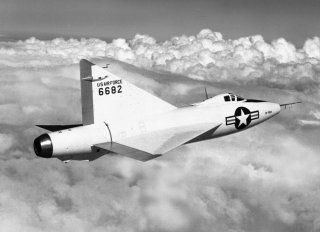Meet the Convair XF-92—the First American Delta-Winged Aircraft
How good was this innovation?
Today we almost expect aircraft, especially those designed for extreme high speeds, to have the delta-wing design. It all began with the Convair XF-92A, a revolutionary looking aircraft that was unlike anything that had flown just a few years earlier.
However, being first meant there were some issues. Simply put, it was not a beloved airplane to the pilots who had the chance to take it up.
“Nobody wanted to fly the XF-92,” National Advisory Committee on Aeronautics (NACA, the predecessor to NASA) test pilot A. Scott Crossfield was quoted to say about his experience with the aircraft. “There was no lineup of pilots for that airplane. It was a miserable flying beast.”
Yet between 1948 and 1953 flown it was—more than 300 times.
The then-radical delta-wing configuration, which resembles a large triangle, was pioneered by German-born Dr. Alexander Lippisch, who conceived more than 50 radical designs including the rocket-powered Me-163B-1 Komet, which was flown by Nazi Germany’s Luftwaffe during World War II. His work with delta-wing aircraft actually began before the war however with simple gilders.
After the war, Lippisch was among the German scientists and engineers that were recruited as part of Operation Paperclip, the secret program of the Joint Intelligence Objectives Agency that brought those individuals to the United States to work on government programs. According to an FBI analysis of his past, it was concluded that Lippisch hadn’t been an ardent Nazi supporter, and he proved rather happy to be able to continue to work on aircraft designs, just for the Americans.
That included the XF-92, the world’s first jet aircraft to feature the radical delta-wing design that resembled a paper airplane. It was so named because it resembled the Greek letter delta. It also offered a number of advantages including reduced drag, while the large surface area increased lift. In addition, the wing was built to be very thin but was still quite strong.
The aircraft was delivered to Muroc Air Force Base, California on April 1, 1958 and its first flight was far from impressive, and consisted of little more than an inadvertent hop during its high-speed taxi test—while its first true flight was made on September 18 of that year, which demonstrated the airworthiness of the radical design and its Phase I testing continued through August 1949.
While the sole XF-92 built was officially designated a prototype, it was actually used as a research aircraft, and during its Phase II flights the Air Force pilots flew the jet to see if it could meet the contract specifications. Among the pilots who flew the aircraft was Major Charles “Chuck” Yeager, who made the maiden Phase II flight on October 13, 1949. It only took two months for the final testing to be completed. The aircraft had proved that a delta-wing aircraft was practical even if the XF-92 had numerous shortcomings including severe pitch problems.
The XF-92 continued to be used in testing until its nose gear collapsed on landing in October 1953 while being piloted by Crossfield, who was fortunately unharmed. However, the XF-92 never flew again, and the aircraft was donated to the University of the South in Sewanee, Tennessee before being transferred to the National Museum of the United States Air Force, where it is currently on display.
The legacy of the program can be seen in the numerous aircraft that followed, which included the F-102 and F-106 interceptor, and even today with the F-22.
Peter Suciu is a Michigan-based writer who has contributed to more than four dozen magazines, newspapers and websites. He is the author of several books on military headgear including A Gallery of Military Headdress, which is available on Amazon.com.
Image: Wikimedia.

